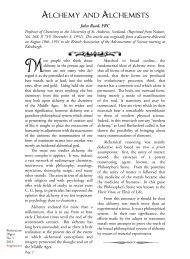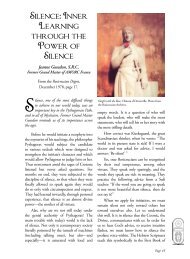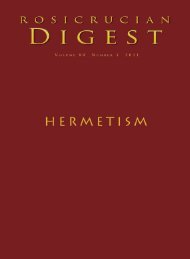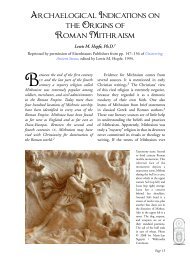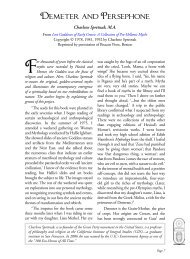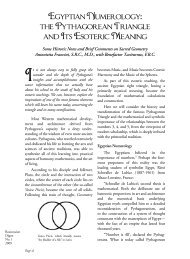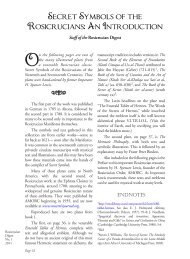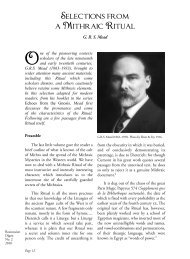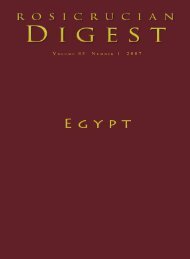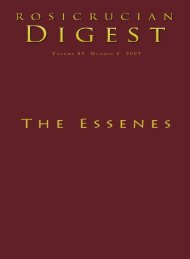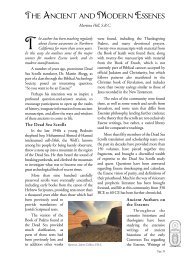The Grand Temple - Rosicrucian Order, AMORC
The Grand Temple - Rosicrucian Order, AMORC
The Grand Temple - Rosicrucian Order, AMORC
You also want an ePaper? Increase the reach of your titles
YUMPU automatically turns print PDFs into web optimized ePapers that Google loves.
Great Libraries—Centers of Civilization<br />
<strong>The</strong> House of Knowledge in Cairo<br />
by Bill Anderson, F.R.C., Editor<br />
<strong>The</strong> Beacon<br />
A thousand years ago Cairo was the brilliant center<br />
of a magnificent civilization, an international<br />
crossroads of commerce and ideas, and its splendid<br />
House of Knowledge was a vast storehouse<br />
of learning and wisdom.<br />
<strong>Rosicrucian</strong><br />
Digest<br />
No. 1<br />
2006<br />
AIRO, the capital of Egypt, is known<br />
primarily, and for many exclusively, for<br />
the Sphinx and Pyramids. Don’t be<br />
fooled, however, for Cairo is a whole lot more<br />
than this. It is a teeming, fascinating city in its<br />
own right, as ancient and important as any of<br />
the Roman cities of Europe—indeed, maybe<br />
even more ancient than any other city in the<br />
world. In their hurry to see the ancient Egyptian<br />
monuments on the Giza Plateau, many tourists<br />
forget that Cairo is an Islamic city and, as such,<br />
has a wonderful inheritance. During <strong>Rosicrucian</strong><br />
trips to Egypt, those taking part may want to<br />
pause and consider the wonders of this medieval<br />
city and its glorious place in history.<br />
Cairo is huge. <strong>The</strong> district of al-Fustát was<br />
built upon the ruins of the Roman fort of<br />
Babylon, named by the Romans after the famous<br />
Mesopotamian city. However, its northeastern<br />
part and the district of Matariya lie over the ruins<br />
of one of the most illustrious cities of ancient<br />
Egypt: Heliopolis, after which the northeastern<br />
part is still named. Heliopolis, the city of the sun,<br />
was the home of Ra. His temple, which is<br />
calculated to be about four times as large as the<br />
temple of Amun at Karnak, was a famous center<br />
of knowledge and wisdom, and one of the first<br />
Page 8<br />
massively organized places of worship in the<br />
world. It drew not only ancient Egyptian seekers,<br />
but also many famous ancient Greeks.<br />
As we can see, and are about to discover, Cairo,<br />
a predominantly Islamic city, has a proud history as<br />
a center of knowledge, both mundane and spiritual.<br />
On June 10, 973, the Fatimid Imam-Caliph al-<br />
Mu’izz rode into his new capital city situated a few<br />
miles to the northeast of Fustát. It was officially<br />
founded on May 3, 970, as al-Mansúriyya, now<br />
renamed Madinat al-Qáhira al-Mu’izziyya, “<strong>The</strong><br />
City of Victory of al-Mu’izz,” or more simply al-<br />
Qáhira, from which comes the name Cairo. <strong>The</strong><br />
name al-Qáhira also refers to the planet Mars,<br />
which was in the ascendant on the day the city was<br />
founded. Al-Mu’izz decorated the city’s four<br />
suburbs with luxurious buildings and delightful<br />
gardens, as he made Cairo into the metropolis of a<br />
great Islamic empire, stretching from Sicily and<br />
Tunisia to Syria and the holy cities of Mecca and<br />
Medina in present-day Saudi Arabia. Cairo, as a<br />
great center of civilization, rivaled Baghdad,<br />
Cordoba, and Constantinople. Egypt under the<br />
Fatimids is generally recognized as one of the<br />
most brilliant periods of Islamic history.




